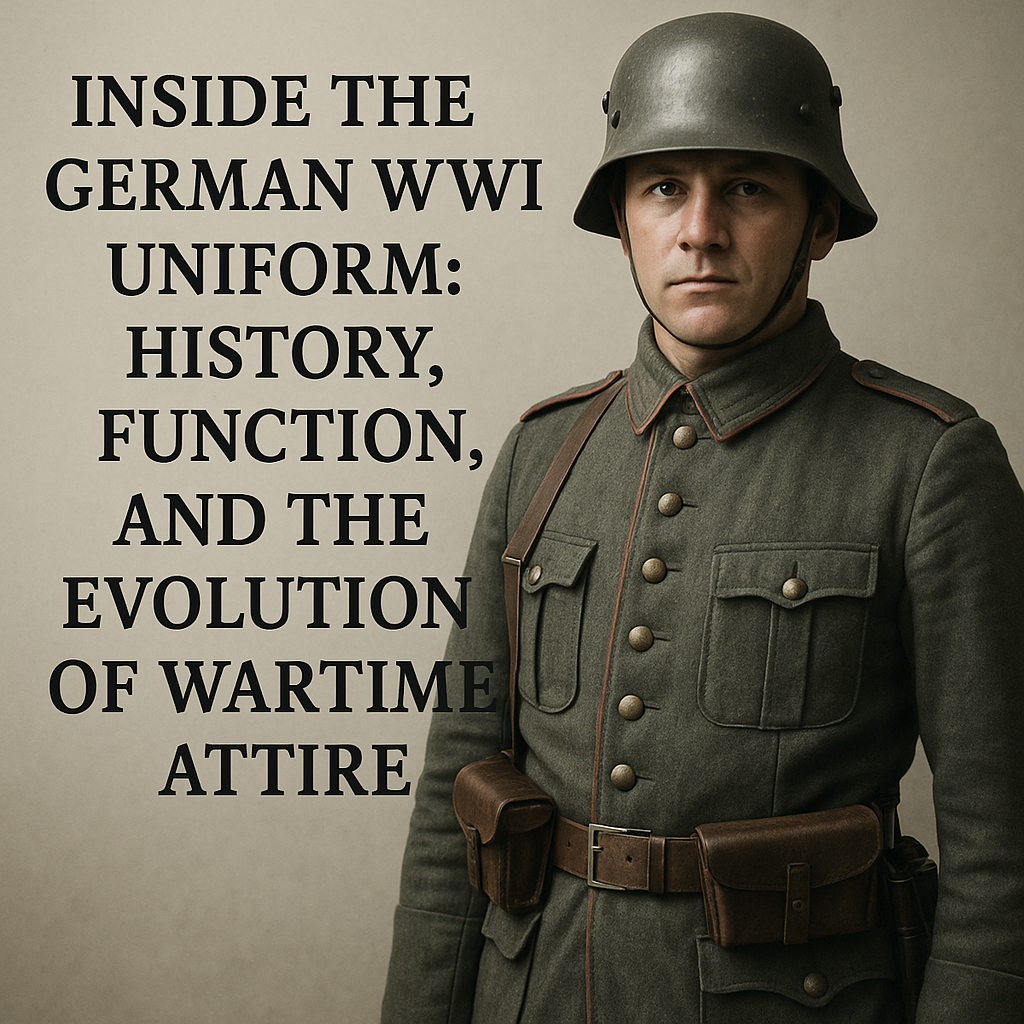
Inside the German WWI Uniform: History, Function, and the Evolution of Wartime Attire
Published on May 22, 2025
German WWI Uniform: A Journey Through Military Evolution
World War I brought seismic shifts to the battlefield — not just in tactics, but also in the way soldiers dressed. Among the most recognizable and impactful wartime attire was the German WWI uniform. This iconic ensemble evolved throughout the war, balancing tradition with the harsh demands of trench combat.
In this detailed overview, we examine the origins, transformation, and legacy of German military uniforms during WWI. We’ll also briefly compare them with other First World War uniforms like those worn by pilots, naval forces, and British troops.
1. The Pre-War Look: Tradition Meets Functionality
At the outbreak of WWI in 1914, German soldiers marched into battle wearing uniforms that still bore a distinctly 19th-century Prussian aesthetic.
Key features of early WWI German infantry uniforms:
- Color: Field-grey (Feldgrau) wool uniforms designed to provide better camouflage than the bright colors of past European conflicts.
- Helmet: The famous Pickelhaube, a spiked leather helmet, still in use from earlier military campaigns.
- Tunic: High-collared, with pleated chest pockets and red piping to denote unit and rank.
- Trousers and Boots: Stone-grey trousers paired with tall black leather boots.
These early uniforms, while striking in appearance, offered little practical defense against the evolving dangers of trench warfare, such as shrapnel, gas, and close-quarters combat.
2. The Shift to Practicality: 1915–1918
As trench warfare turned brutal and static, practicality began to override formality in uniform design. The German army realized that its soldiers needed better protection and more agile clothing.
Major changes during mid-to-late WWI:
- Helmet Evolution: The leather Pickelhaube was replaced with the steel Stahlhelm in 1916, offering much-needed protection for the head and neck.
- Simplified Uniforms: Red piping and decorative buttons were phased out. Uniforms were streamlined for mass production and easier maintenance.
- Boot Replacement: Sturdy ankle boots were now used with puttees (cloth leg wrappings) for greater mobility and easier repair.
- New Fabrics: Uniforms began to be made from more rugged, sometimes lower-quality materials as resources grew scarce.
This transformation reflected the army’s urgent need to outfit millions of soldiers in a cost-effective yet battle-ready manner.
3. German WWI Stormtrooper Uniforms: Designed for Infiltration
One of the most innovative developments of WWI was the introduction of the stormtrooper, or Sturmtruppen, units. These elite soldiers required a uniform that allowed them to move swiftly, carry explosives, and operate under stealth conditions.
What set stormtrooper uniforms apart?
- Flexibility: Tunics were often modified with reinforced elbows and shoulders, allowing ease of movement during hand-to-hand combat.
- Headgear: The Stahlhelm became standard, often paired with early forms of camouflage or netting.
- Equipment: Stormtroopers carried light gear — grenades, trench knives, and pistols — allowing for speed over endurance.
- Protective Gear: Gas masks and gloves were essential, especially for night raids or chemical attacks.
These uniforms symbolized the shift toward specialized, tactical roles in warfare. Unlike regular infantry, stormtroopers were given gear that matched their dynamic new role on the battlefield.
4. Comparing WWI Uniforms from Other Forces
While German military attire was among the most influential of the war, other nations also saw significant developments in uniform design.
World War 1 Pilot Uniforms
Pilots of WWI needed specialized garments to survive the frigid conditions at high altitude. Standard uniforms included:
- Leather flight jackets for warmth
- Goggles to shield from wind and debris
- Silk scarves to prevent neck irritation during long flights
Though less armored, these uniforms were practical for early aviation and became iconic in post-war fashion.
World War I Navy Uniforms
Naval uniforms remained more traditional but adapted to life at sea:
- Double-breasted tunics and navy blue color schemes
- Flat caps with unit insignia
- Wool trousers for insulation on deck
The WWI US Navy uniform, in particular, emphasized formality but began introducing more functional elements, especially for engineering and submersible crews.
First World War British Uniform
The British army also transitioned to a more pragmatic uniform:
- 1902 Service Dress in khaki wool
- Brodie helmet for basic protection
- Webbing gear to distribute weight and carry essential supplies
This uniform became the model for many Commonwealth forces and marked a decisive break from colorful 19th-century military fashion.
5. The Legacy of the German WWI Uniform
The German WWI uniform, especially the stormtrooper gear, influenced not only future German military styles but also modern combat design principles around the world.
Key takeaways:
- Uniforms became a blend of camouflage, utility, and protection.
- Specialization of roles led to more tailored military attire.
- The aesthetic of German WWI uniforms continues to inspire collectors, reenactors, filmmakers, and historians.
Conclusion
The German WWI uniform represents a pivotal shift in military apparel — from ornate traditions to battlefield functionality. Through the evolution of their gear, German forces adapted to one of the most grueling and transformative conflicts in human history.
By understanding these uniforms, we gain more than just knowledge of fabric and design — we glimpse the daily struggles, innovations, and lives of those who wore them.
